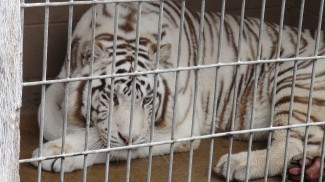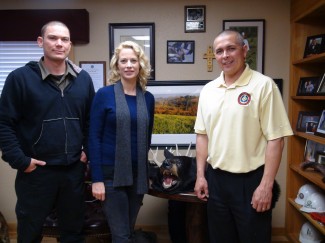INTERVIEW: Nat Geo Wild’s ‘Animal Intervention’ finds big cats in small places

We have all read the headlines. We know the consequences can be deadly. And now Nat Geo Wild has turned on the cameras to document it all.
Animal Intervention, the new reality series with co-hosts Alison Eastwood and Donald Schultz, travels the United States in search of people who are in over their head with exotic animals as pets. The new series premieres Tuesday, Oct. 2 at 9 p.m. with an episode that features a magician who uses three tigers and two leopards in his act, and a couple in Louisiana that houses four capuchin monkeys in their RV.
Eastwood and Schultz enter each situation not as law-enforcement officials but as helping hands. They want to remedy these red-flag situations before any bloodshed occurs. Their goal is to help both animals and humans.
Here’s a portion of our interview with Schultz.
On his biggest surprise …
I think the biggest surprise was how in certain areas how relaxed some of the laws are and how easy it was to acquire some of these animals. A lot of the time if you go and adopt a dog, they’ll do a really stringent background check and look into you and make sure that your homeowner knows about it. Often times … you can just buy a predator like a tiger or a lion without any background check. And that’s kind of scary because these animals are ultimately like most weapons. … Conversely, if you have prohibition and make everything illegal, then it becomes black market. Everything goes underground, which is even worse, in my opinion. So I think a happy medium (is that) these animals are regulated, but people can still have them.

On owners who went overboard and treated their animals like children …
As soon as the animal starts taking on the role of what they call their children … then there’s something going on. There’s deeper issues going on there. Ultimately, if you want a companion, a dog is perfect. It will love you. It probably won’t kill you. It doesn’t get very big. But these people (with) … monkeys and tigers and bears, and unfortunately they just don’t give the same sort of companionship that dogs do. I mean dogs have been in captivity for so long that they’ve grow accustomed to humans. Whereas tigers, sometimes the cat has only been in captivity for a few years, so they just don’t have the bond that a dog would have.
On his intervention techniques …
The big thing is we’re not law enforcement. We’re not going there, kicking down doors and pointing fingers. And that was very important to me. … My hope was two-fold. One of them was to help the owners and the animals. And sometimes that was … spending two or three days with them, going through their daily schedule and seeing how much work goes into it. A lot of times, people get into it, and it’s been so long since they’ve had a vacation or day off that they’ve forgotten what it’s like. So you go and work with them for a day … and then they start explaining. They sort of see the folly of their ways. It’s just like holding a mirror up to them and then (they) realize that might not be the best idea for themselves or for the animals.
The other side of it is a hope people at home look at how difficult it is to keep a tiger or how difficult it is to have a bear, or any of these other animals, and realize it’s not for everyone. Just because we live in America doesn’t mean everyone should have a machine gun. Yeah, sure, I think people should have the right to get a dangerous animal, if they go through the permitting process, but I don’t think it’s a right for every American to own a tiger. I don’t think it’s a good idea.
On the psychological aspect of the show …
One of the things is oftentimes people entered into it with the best intentions. They want to rescue animals. They want to help a couple of creatures. They want to open a zoo for kids for after-school activities, kind of like that. And as soon as they got a name in their neighborhood that they had lions and tigers, people started seeing it as a dumping ground or a shelter and just left animals there. And before you know it, some of these people are up to 70 or 80 tigers and lions.
They’re financially stressed. They don’t know how to get out of it. They can’t give the animals up because they fear that the animals will be euthanized. So they eventually become exactly what they were trying to save the animals from, and that’s obviously very, very sad. And our hope when we went there is to point that out to them. Be like, ‘You do have good intentions. You are a good person. You are trying your best. But you’re failing, and you need help.’ And that’s pretty much what we were trying to do.
On working with Alison Eastwood …
She’s amazing. She’s really like a free spirit, hippie … beautiful person. And she really does have the animal’s and people’s interest at heart. I come from a dangerous animals background. She comes from a Hollywood background. But I think we worked really well together because any place that I had a deficit, she made up in. She’s very emotional, very easy to speak to, and that really helps a lot of the people. If you have a 6-foot-2 South African knocking on your door, a lot of people just ran away. So with Alison, it was a lot easier to speak to a lot of these people.
On the future prospects of the show …
Unfortunately, I think there’s enough stories to go for about 10 seasons.
By John Soltes / Publisher / John@HollywoodSoapbox.com
-
Animal Intervention premieres on Nat Geo Wild Tuesday, Oct. 2 at 9 p.m. Click here for more information.


I would like to know what happened to the four capuchin monkeys and did they go back to Louisiana